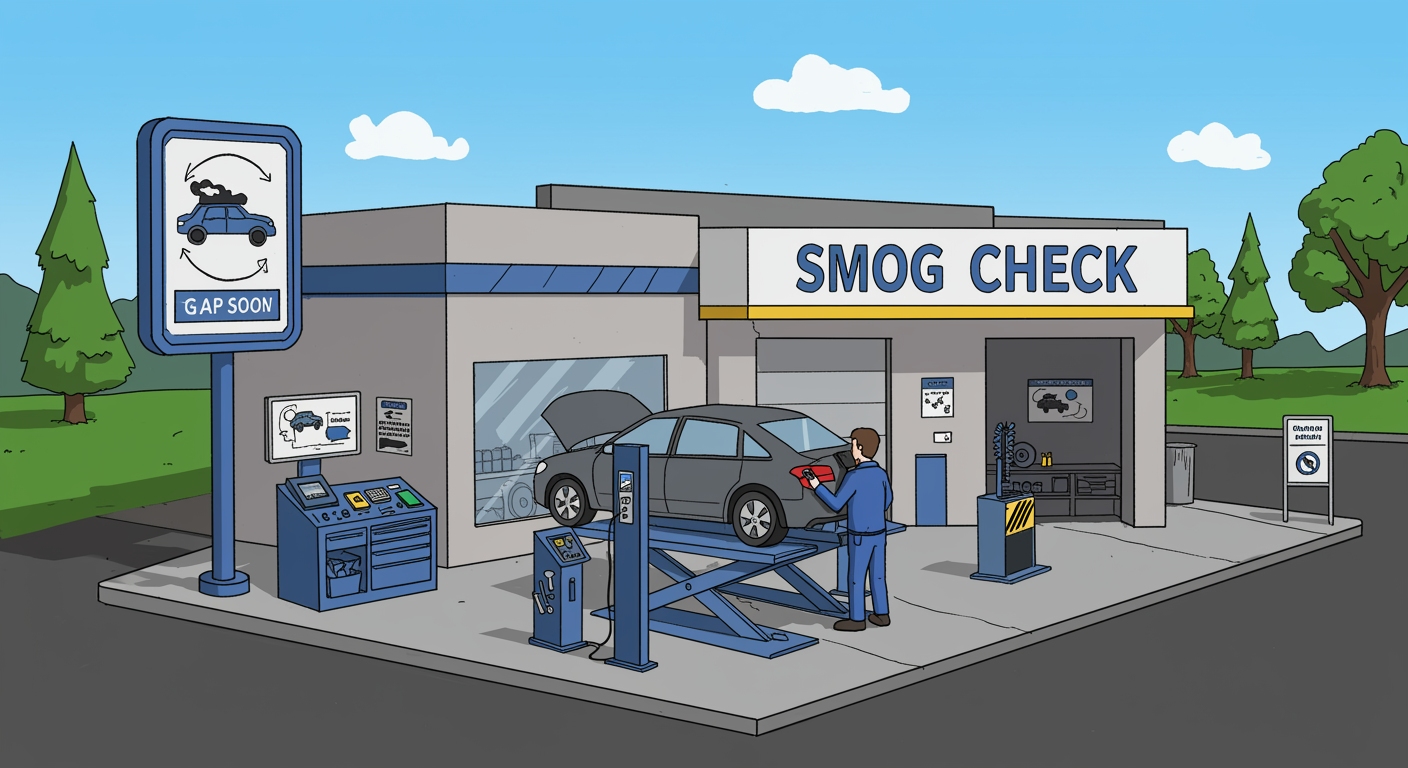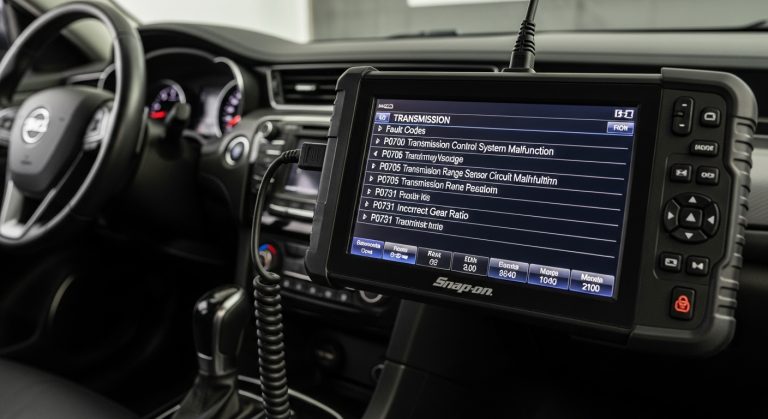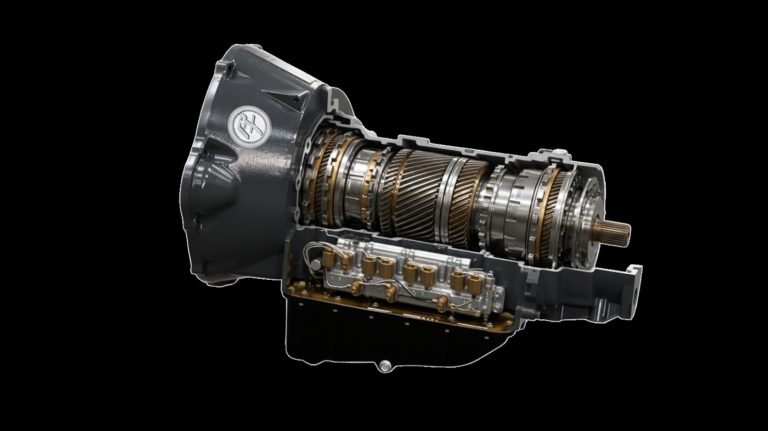Yes, you should change your oil before a smog check if it’s due or near due. Fresh oil reduces harmful emissions by minimizing contaminants entering the combustion chamber through the crankcase ventilation system. Dirty oil can increase hydrocarbons and other pollutants, risking a test failure. Changing it a few days prior helps optimize engine efficiency for accurate results. Stick around to uncover deeper insights into maximizing your vehicle’s performance for smog tests.
Key Takeaways
- Changing oil before a smog check can reduce emissions by minimizing hydrocarbon output through the crankcase ventilation system.
- Fresh oil improves engine efficiency, potentially lowering pollutants like CO and NOx during the test.
- Dirty oil can increase emissions by clogging the PCV system and causing incomplete combustion.
- Replace old or contaminated oil a few days before the test to optimize engine performance.
- Ensure the vehicle is driven adequately after an oil change to reset OBD monitors for accurate results.
Understanding Smog Checks and Engine Oil
A smog check is a critical inspection mandated in states like California to evaluate your vehicle’s emissions and verify it meets air quality standards.
A smog check, vital in states like California, assesses vehicle emissions to ensure compliance with essential air quality standards.
Since 1984, this program targets high-emission vehicles for repair or retirement, enhancing air quality.
You’ll need this biennially, at ownership change, or first registration, typically for gasoline, hybrid, or alternative fuel vehicles from 1976 onward, barring exemptions like electric cars or newer models.
During the check, technicians perform visual and functional inspections of emission controls, like the catalytic converter and EGR valve.
They’ll also test your on-board diagnostics (OBD) for 1996+ models and measure tailpipe pollutants (HC, CO, NOx).
Make sure you’ve addressed any check engine light issues beforehand, as they’ll cause an automatic failure. Additionally, adhering to recommended oil change intervals can help maintain engine efficiency and prevent potential emission failures.
Depending on your vehicle’s needs, you may be directed to specific types of smog check stations, such as STAR stations or Test-Only stations, for specialized inspection requirements.
How Dirty Oil Impacts Emissions?
When you let your engine oil get dirty, you’re allowing contaminants like hydrocarbons to build up, directly boosting harmful emissions that smog checks measure.
This oil contamination doesn’t just increase hydrocarbon output; it also accelerates engine wear by reducing lubrication and causing friction on critical components.
As a result, your engine’s performance suffers, potentially leading to even higher emission levels during testing.
Furthermore, dirty engine oil can lower fuel economy by up to 12%.
Moreover, dirty oil can lead to the formation of sludge, which further impairs engine efficiency and increases emission levels.
Oil Contamination Effects
How does dirty oil affect your vehicle’s emissions during a smog check?
When you neglect oil changes, contaminants build up, harming your engine’s performance.
Dirty oil clogs the Positive Crankcase Ventilation (PCV) system, disrupting the air-fuel mix and increasing crankcase pressure, which can elevate emissions.
It also leaks past worn components, coating your catalytic converter and poisoning its catalysts with additives like phosphorus, reducing efficiency and boosting pollutants like CO and NOx.
Additionally, viscous oil heightens friction, hampering combustion and engine health, while increased wear raises particulate matter in exhaust.
Don’t overlook this: contaminated oil compromises lubrication, accelerates wear, and indirectly spikes emissions.
Changing your oil before a smog check can help assure cleaner operation and better results. Using high-quality oils with superior viscosity resistance may further reduce the risk of emissions issues by maintaining better engine protection over time.
A faulty PCV valve, often worsened by dirty oil, can cause excessive emissions by failing to redirect blowby gases for combustion failing to redirect.
Hydrocarbon Emission Increase
Why does dirty oil lead to a spike in hydrocarbon (HC) emissions during a smog check?
When you neglect oil changes, contaminants build up, directly impacting your engine’s exhaust.
Dirty oil holds excess hydrocarbons, creating fumes in the crankcase that get pulled into combustion via the PCV system, raising HC levels in exhaust gases.
Thinned oil also slips past piston rings, burning and releasing more hydrocarbons.
Here’s how dirty oil worsens emissions:
- Deposits Formation: Dirty oil leaves deposits in the combustion chamber, causing incomplete combustion—a key HC source.
- Catalytic Converter Poisoning: Oil additives like phosphorus harm the converter, reducing HC conversion efficiency.
- Increased Blow-by: Degraded oil boosts friction, worsening blow-by gases that carry HC-rich oil mist into combustion.
Regular oil changes, such as those recommended for wear protection, can help prevent these problems by ensuring optimal engine performance.
Changing old motor oil before a smog check can significantly lower these emission levels lowering emission levels.
Engine Wear Impact
Dive into the harsh reality of engine wear caused by dirty oil, and you’ll see its direct impact on emissions during a smog check.
When oil degrades, it loses lubrication, increasing friction and heat in your engine.
This forces your engine to work harder, burning more fuel and worsening combustion efficiency.
Dirty oil also carries contaminants like soot and metal particles, causing abrasive wear on piston rings and cylinders.
This damage leads to compression loss, incomplete fuel burning, and higher pollutants like Carbon Monoxide.
Worn components allow oil to burn in the combustion chamber, raising Particulate Matter emissions.
Furthermore, burned oil additives can poison catalysts, reducing their effectiveness.
Don’t ignore this—dirty oil directly hikes your emission levels.
To combat these effects and protect older engines, consider switching to High Mileage oil for vehicles exceeding 75,000 miles.
The Link Between Oil Volatility and Hydrocarbons
As you consider your vehicle’s emissions, understand that oil vapors can greatly boost hydrocarbon levels by escaping into the combustion process. For instance, oils that meet API and ILSAC standards can help reduce such volatility in everyday driving conditions.
Notice how the Positive Crankcase Ventilation (PCV) system channels these volatile oil fumes back into the engine, potentially disrupting the air/fuel mix and worsening incomplete combustion.
Recognize that this directly contributes to higher hydrocarbon emissions, a critical factor during a smog check.
Keep in mind that hydrocarbon volatility, influenced by factors like temperature and molecular weight, can increase evaporation rates and thus elevate emission levels during vehicle operation hydrocarbon volatility influenced.
Oil Vapors Increase Emissions
While it might seem unrelated at first, engine oil plays a critical role in vehicle emissions through its volatility.
When you’re driving, the heat in your engine causes oil to vaporize, especially near the piston rings.
These oil vapors turn into unburned hydrocarbons (HC), directly boosting exhaust emissions and contributing to smog-forming volatile organic compounds (VOCs).
Here’s how oil volatility impacts your vehicle’s emissions:
- High Volatility: Oils with more light-end molecules evaporate faster, increasing HC emissions.
- Temperature Effects: At high temps (like 250°C in Noack tests), volatile oils lose mass, adding to pollutants.
- Smog Contribution: Oil-derived VOCs react with NOx in sunlight, worsening air quality.
- Aging Oil Impact: As oil ages, its volatility may level off, but fuel dilution from short trips or idling can still increase hydrocarbon emissions.
PCV System Impact
Let’s examine how oil volatility ties directly to your vehicle’s Positive Crankcase Ventilation (PCV) system and hydrocarbon emissions. When oil vaporizes due to high volatility, it travels through the PCV system, potentially forming deposits on components. You’ll notice that higher volatility oils generate more vapor, risking clogs, while low-volatility synthetics minimize this issue. The PCV system recirculates crankcase gases for combustion, curbing emissions, but only if it’s functioning properly. A malfunctioning PCV system can lead to increased hydrocarbon emissions due to ineffective gas recirculation.
Check this table for clarity:
| Factor | High Volatility Oil | Low Volatility Oil |
|---|---|---|
| Vapor Generation | High, more PCV deposits | Low, fewer deposits |
| PCV Valve Clogging | Increased risk | Reduced risk |
| System Efficiency | Compromised over time | Maintained longer |
| Oil Quality Impact | Faster degradation | Slower degradation |
Keep your PCV healthy with quality oil!
Hydrocarbon Levels Rise
Engine oil plays a critical role in hydrocarbon (HC) emissions, directly impacting your vehicle’s smog check results.
When oil enters the combustion chamber, it burns incompletely, releasing HCs and soot through the exhaust.
Higher oil volatility, especially with fresh or degraded oil, means more evaporation, contributing to crankcase vapors that sneak into combustion, spiking HC levels.
Consider these key factors affecting HC emissions:
- Oil Volatility: Lighter oils evaporate faster, increasing HC-laden vapors.
- Degradation: Old, contaminated oil boosts consumption and volatility, worsening HC output.
- Engine Wear: Aging engines consume more oil, elevating HC via cylinder wall absorption.
To further enhance engine efficiency and reduce emissions over time, incorporating fuel additives can help maintain overall performance.
Since smog tests measure HCs, don’t risk failure—swap out old or volatile oil before your check to cut emissions.
Research also shows that higher fuel volatility can similarly increase emissions, as it correlates with elevated particle number emissions in engines.
Benefits of Fresh Oil for Engine Performance
How does fresh oil impact your engine’s performance? When you use fresh oil, you’re ensuring superior lubrication that minimizes friction between moving parts, reducing wear and enhancing smoothness.
It lowers internal resistance, potentially boosting fuel efficiency. For optimal results, selecting a high-quality synthetic oil with advanced wear protection features can provide even greater engine longevity and performance.
Beyond lubrication, fresh oil absorbs and dissipates heat from critical components like pistons, preventing overheating and maintaining ideal operating temperatures.
Moreover, it’s packed with detergents that clean internal surfaces, suspending dirt and preventing sludge buildup, while carrying contaminants to the filter.
Fresh oil also seals piston rings to cylinder walls, optimizing compression for efficient combustion and power output, which contributes to better overall engine efficiency.
Finally, its anti-wear additives and corrosion inhibitors protect against erosion and rust, extending your engine’s lifespan with a robust defense for essential components better overall engine efficiency.
When to Schedule an Oil Change Before Testing?
When should you schedule an oil change before a smog check?
If your oil’s due or near due, get it changed before testing.
Dirty oil can increase pollutants via the crank ventilation system, so fresh oil helps your engine run cleaner. For optimal performance, opting for a premium oil like Mobil 1 can provide superior protection during the test.
Timing’s critical if there’s a chance the battery was disconnected during service.
Consider these key timing tips:
- Check Oil Condition: Change it if it’s old or contaminated, ideally a few days prior if battery disconnection’s a risk.
- Battery Disconnect Awareness: If disconnected, drive 100-200 miles over a week to reset OBD monitors before testing.
- Warm-Up Drive: After the change, do a 15-20 minute warm-up drive, ideally at highway speeds, right before heading to the station.
- Engine Efficiency: Fresh oil reduces carbon buildup reduces carbon buildup, which can lower emissions during the test.
Other Key Maintenance Tips for Passing Smog Tests
Precision matters when preparing your vehicle for a smog test.
Start by ensuring your “Check Engine” light is off; if it’s on, diagnose and fix issues like a faulty oxygen sensor or loose gas cap before testing. Drive 100-200 miles post-repair to reset OBD monitors.
Replace dirty air filters and secure your gas cap to prevent EVAP leaks. Swap out worn spark plugs and inspect for exhaust leaks, especially before the catalytic converter, to avoid skewed readings.
Warm up your engine with a 15-20 minute highway drive before the test for maximum catalytic converter efficiency. Consider getting an oil change to ensure dirty oil doesn’t contribute to emissions failure.
Finally, check tire pressure and coolant levels, and consider a pre-inspection to catch hidden problems early. For enhanced engine protection, consider using synthetic oil options that align with your vehicle’s needs. Stay proactive to pass with ease.
The Role of Oil Type in Reducing Emissions
Choosing the right engine oil plays a critical role in minimizing your vehicle’s emissions during a smog check.
You’ve gotta pick oil with the proper viscosity and additives to boost engine efficiency and cut down on pollutants.
Low-viscosity oils reduce friction, improving fuel economy by up to 3.5% and slashing CO2 emissions in certain engines.
Consider these key factors when selecting oil:
- Viscosity Matters: Opt for lower viscosity oils to decrease mechanical losses and fuel use.
- Additive Benefits: Choose oils with friction modifiers and detergents to lower energy consumption and clean deposits.
- Quality Counts: Use high-quality oil to prevent degradation, avoiding increased friction and particulate emissions.
Make sure you’re using oil that supports cleaner combustion and protects emission systems.
Following the manufacturer’s recommended oil type ensures optimal performance and emission reduction.
Synthetic vs. Conventional Oil for Smog Results
Let’s shift focus from oil types to a specific comparison that impacts your smog check results: synthetic versus conventional oil.
Synthetic oil, with its uniform molecular structure and fewer impurities, burns cleaner, reducing emissions through less sludge and better engine efficiency.
Synthetic oil’s uniform structure and purity ensure a cleaner burn, cutting emissions by reducing sludge and boosting engine efficiency.
You’ll notice improved cold-start lubrication and high-temperature stability, minimizing wear and optimizing combustion.
Conventional oil, derived from crude, breaks down faster, forming deposits that can increase emissions by making your engine work harder.
While synthetics are pricier, their longer drain intervals and reduced burn-off offer environmental and potential fuel economy benefits.
Studies show synthetic oil can improve engine performance by up to 47% compared to conventional options, potentially aiding in cleaner smog test results engine performance improvement.
However, don’t expect either to fix underlying engine issues during a smog test—repairs might still be necessary for passing.
Choose wisely based on your vehicle’s needs.
Common Myths About Oil Changes and Smog Checks
Many drivers harbor misconceptions about the role of oil changes in passing a smog check.
You might think fresh oil guarantees a pass, but it doesn’t fix underlying emission issues like faulty sensors or converters.
Smog tests focus on exhaust, not oil condition, unless it’s severely degraded.
Bust these myths with facts:
- Oil Change Isn’t Mandatory: If it’s not due, don’t rush to change it; focus on critical issues like check engine lights.
- Oil Color Doesn’t Equal Readiness: Dark oil is normal due to detergents; judge by mileage, not appearance.
- Additives Aren’t Magic: They can’t replace proper maintenance or fix major emission failures. Modern vehicles often have extended oil change intervals, so consult the manual for accurate guidance.
Don’t rely on quick fixes; make sure your vehicle’s emission system is sound.
Maximizing Engine Efficiency for Better Test Outcomes
If you’re aiming to pass your smog check, focus on enhancing engine performance to cut down emission levels.
Start by ensuring your vehicle’s systems—like the fuel, ignition, and exhaust—are in top shape through regular maintenance and timely repairs.
These steps can greatly boost combustion efficiency and minimize pollutants during the test.
Additionally, consider changing your oil if it’s close to due, as fresh oil can improve engine performance and help reduce emissions during the inspection.
Enhancing Engine Performance
To maximize your engine’s efficiency for a smog check, focus on optimizing its performance before heading to the test station.
You’ve gotta make sure your vehicle runs at peak condition for accurate test results.
Start by warming up your engine with a 20-minute drive to reach ideal temperature, guaranteeing efficient fuel burn. Regular maintenance, such as timely oil changes, helps ensure your engine operates cleanly and reduces emissions output.
Here’s how to fine-tune your setup:
- Maintain Fluids and Filters: Swap out old oil if it’s due and replace a dirty air filter for better airflow and combustion.
- Inspect Ignition System: Check spark plugs and wires for wear; replace faulty ones to prevent misfires.
- Verify Fuel Quality: Use high-quality fuel and consider additives to clear carbon buildup for smoother operation.
Prep smart, and you’ll ace the test!
Reducing Emission Levels
Gear up to slash your vehicle’s emission levels by fine-tuning its efficiency before a smog check.
Start by driving for 15-20 minutes prior to arrival to guarantee your engine and catalytic converter hit ideal temperatures, burning off more hydrocarbons.
Don’t let your engine cool off with long waits before testing.
Next, maintain your fuel system with high-quality fuel and additives to clear carbon deposits, enhancing combustion efficiency.
Change your oil if it’s due—old oil increases hydrocarbon content via the PCV system.
Replace worn spark plugs and verify your air filter’s clean for proper airflow.
Check tire pressure, fix exhaust leaks, and verify your gas cap seals tightly.
Address any Check Engine Light codes promptly for cleaner results.
Schedule your test on a cooler day to help your engine perform optimally under less stressful conditions.
Frequently Asked Questions
Can Oil Additives Help Pass a Smog Check?
Hey, you’re wondering if oil additives can help pass a smog check.
While they’re designed to enhance lubrication and engine cleanliness, most oil additives, like friction modifiers or dispersants, don’t directly reduce emissions for testing. Some, like ZDDP, might even increase particle emissions or harm catalytic converters.
Stick to fuel additives for cleaning deposits and lowering emissions.
For smog checks, focus on proven pre-test measures instead of relying on oil additives.
Does Oil Brand Affect Smog Test Results?
Hey, when you’re wondering if oil brand affects smog test results, know that it’s not the brand itself that matters most.
Focus on the oil’s condition and specifications.
Stick to oils meeting your vehicle’s API and SAE standards, as these directly impact emissions.
Dirty or substandard oil can increase hydrocarbons and carbon monoxide.
Don’t stress over brand—prioritize fresh, spec-compliant oil to optimize your engine’s performance during testing.
Should I Use Thicker Oil Before Testing?
Think of your engine as a weary warrior—don’t burden it with the wrong armor!
When considering thicker oil before testing, tread carefully.
Thicker oil, like 10W-40 or 20W-50, might reduce blow-by and hydrocarbon emissions in worn engines by sealing gaps.
However, if it’s too viscous, you’re risking poor lubrication and increased friction.
Stick to manufacturer specs; don’t gamble with additives or extremes that could harm your engine’s performance.
How Often Should Oil Be Checked Pre-Test?
Hey, when it comes to how often you should check your oil before a smog test, make it a habit to inspect it at least a week prior.
Verify the oil level and condition—look for clarity and proper viscosity.
If it’s dark or gritty, don’t wait; change it.
Routine checks every 3,000 miles or per your manual guarantee you’re not caught off guard during emissions testing.
Stay proactive!
Does Oil Age Impact Test Failure Rates?
Hey, let’s delve into how oil age impacts smog test failure rates.
If you’re running old, contaminated oil, you’re likely increasing hydrocarbon and carbon monoxide emissions through the PCV system.
Oil past 5,000 miles often carries sludge and debris, spiking pollutant levels.
This can tip a marginal test into failure.
While not the sole factor, aged oil’s volatility and fumes directly worsen combustion emissions, raising failure risks.
Ready for the Road: Make Your Smog Check a Success
As you gear up for your smog check, picture your engine as a pristine, well-oiled machine, humming with efficiency. Don’t wait—schedule that oil change now to guarantee clean combustion and lower emissions. With fresh oil, you’re not just passing a test; you’re breathing life into your vehicle’s heart. Choose the right oil type, and you’ll cruise through the inspection, leaving a cleaner footprint on the road ahead.




